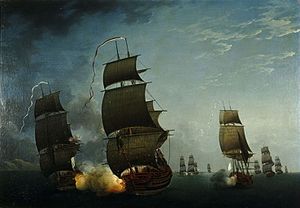HMS Ardent (1764)

|
|
| History | |
|---|---|
|
|
|
| Name: | HMS Ardent |
| Ordered: | 16 December 1761 |
| Builder: | Blades, Hull |
| Laid down: | 15 January 1762 |
| Launched: | 13 August 1764 |
| Commissioned: | October 1773 |
| Captured: | 17 August 1779, by French Navy |
|
|
|
| Name: | Ardent |
| Acquired: | 1779 |
| Captured: | 14 April 1782, by Royal Navy |
| Notes: |
|
|
|
|
| Name: | HMS Ardent, later Tiger |
| Acquired: | 14 April 1782 |
| Renamed: | 28 August 1783 |
| Fate: | Sold out of the service, 10 June 1784 |
| General characteristics | |
| Class and type: | Ardent-class ship of the line |
| Tons burthen: | 1379 32⁄94 (bm) |
| Length: |
|
| Beam: | 44 ft 4.5 in (13.526 m) |
| Depth of hold: | 19 ft (5.8 m) |
| Propulsion: | Sails |
| Sail plan: | Full rigged ship |
| Complement: | 500 officers and men |
| Armament: |
|
HMS Ardent was a 64-gun third-rate ship of the line of the Royal Navy. She was built by contract by Hugh Blaydes at Hull according to a design by Sir Thomas Slade, and launched on 13 August 1764 as the first ship of the Ardent-class. She had a somewhat turbulent career, being captured by the French in 1779, and then re-captured by Britain in 1782.
The Ardent was first commissioned in October 1774 under Captain Sir George Douglas. In 1778, under the command of Captain George Keppel, she was with Admiral Lord Howe's squadron off New York, defending the town from the larger French fleet under the command of Admiral d'Estaing. The two forces engaged in an action off Rhode Island on 11 August, though both fleets were scattered by a storm over the following two days. She returned home to Portsmouth and was paid off in January 1779.
June 1779 saw Ardent recommissioned under the command of Captain Phillip Boteler, sailing from Plymouth in August to join Sir Charles Hardy in the Channel. According to the ship's logs, as many as 4/5 of the crew were landmen, and neither Boteler nor the captain of the Marlborough, in whose company Ardent was sailing, were aware that a French fleet had put to sea. Ardent encountered a fleet two days after sailing, and after receiving the correct replies to the private signal, ran down to meet them. The fleet however was a Franco-Spanish fleet, somehow in possession of the Royal Navy signal code book, thus permitting the correct response to Ardent's signals.
...
Wikipedia
